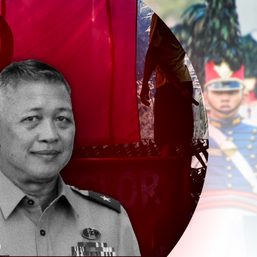SUMMARY
This is AI generated summarization, which may have errors. For context, always refer to the full article.
![[The Slingshot] EDSA began the day Ninoy died](https://www.rappler.com/tachyon/2023/08/tl-edsa-began-when-ninoy-died.jpg)
It was the elegant writer Carmen Guerrero Nakpil who had styled the prose that had captured the incredulity the Marcoses had of the great multitude that accompanied the burial of Ninoy Aquino.
The Marcoses had believed that they were pampered by the adulation of the public. But watching Ninoy’s funeral on TV humiliated them.
“They had been crushed, struck dumb by the enormity of what they were seeing on the video screen,” Imelda told Guerrero Nakpil. They had very little inkling of the public mood.
Guerrero Nakpil was aghast that the Marcos couple never even suspected that people hated them with such unnerving passion, that “they simply could not plumb the depths of the people’s rage.” That, she said, was the beginning of the crumbling of the Marcos empire, and it did not happen on February 1986.
The Marcoses used a lethal cocktail of maneuvers that followed Ninoy’s assassination. We all are familiar with it even today – lies and the weaponization of the law, under an environment of economic downturn. When there is no food on the people’s table, add lying and it becomes a recipe that should forewarn anybody who sits in Malacañang, including the thieving tradpols in Congress today, who use lying as their principal strategy of misgoverning.
And that is why the historical truth about the Marcoses and Martial Law must be persistently defended. That exactly is what Project Gunita has committed itself to. It is a group of students dedicated to history research to popularly disseminate digitized copies of the so-called Mosquito Press that flourished alternatively during Martial Law’s strict censorship. For example, they have made available a rich archive of the published proceedings of the Agrava Board that investigated the Ninoy Aquino murder. They have also digitized books that were rather banned by the dictatorship.
Led by student writer Karl Patrick Suyat, Project Gunita has even linked itself with the revival of the August Twenty One Movement, the famous ATOM, a leading spearhead of the EDSA People Power Revolution. Karl and his colleagues weren’t born yet when Ninoy was assassinated, but how they live vicariously the Martial Law years astound us, all in the service of history for future generations.
Painstaking research by Project Gunita has even traced down some of the key witnesses of the Ninoy assassination. Rebecca Quijano, dubbed the Crying Lady because she emerged from that China Airlines flight weeping profusely, saw who pulled the trigger on Ninoy’s nape. From a window seat on the plane’s first class section, Quijano saw that one of Ninoy’s military escorts had shot him on the back of his head.
Quijano and many of these names have been forgotten. Project Gunita resurrects them for the sake of historical truth. One of them was one of the most reluctant witnesses to have given his eyewitness testimony of the assassination. Why did Ramon Balang resist testifying? He had feared for his life. Elements of the Marcos military and government agents had been shadowing him. That was when he decided to seek refuge from lawyer friends, who then urged him to testify before the Agrava Board.
On August 21, 1983, Ramon Balang was a Philippine Airlines ground engineer. Around 1 pm of that day, China Airlines Flight 811 had landed at the Manila International Airport. Ramon was tasked to register CAL Flight 811 after it had taxied to Bay 8 of the airport terminal. Ramon then went around the aircraft to do a round check, as was his job.
Let Karl in his Facebook page describe the witness: “As he walked to the post where the register sheet was being filed – directly under the air bridge connecting the plane and the airport building – he heard rustling feet on an emergency staircase nearby. It was Senator Aquino and his military escorts, flanking him from the time they fetched him [from] his seat.”
“Ramon turned, then looked away. But a gunshot rang out, and when he looked back, Ninoy was already fallen on the tarmac. He then saw Rolando Galman holding his hands up while soldiers trained their Armalites at him. He too, was gunned down. Ramon saw it all.”
Rolando Galman, as Ramon had witnessed, could not have shot Ninoy because military men already surrounded him. In fact, Galman was talking animatedly with the soldiers, Balang related. But that was not the narrative of the military and even of Marcos. The dictator had promptly announced immediately after the assassination that the assassin was a communist gunman. That was the reason why Balang went into hiding. What he had seen did not coincide with the well-confabulated Malacañang version. Naturally he was a target for silencing.
Unknown to Balang, however, photographer Louie Perez had taken 29 successive shots of the tarmac scene, one of which confirmed his presence at the scene of the crime. It was used as Exhibit 280 in the Agrava Board hearings.
Balang was the first civilian witness to testify who refuted the official state version. When he agreed to testify, it was also on the condition that it was a closed-door testimony. Even his name was not revealed to media.
Later, on December 29, 1983, he gave an open testimony that was recorded by the world’s media.
On February 1984, an airport cargo loader gave testimony that corroborated Balang’s. Fred Viesca, then 24 years old, was unloading containers from the plane. He was about 20 yards from the stairway when he heard a shot. He then saw a “man in white” fall from the staircase to the tarmac.
Another airline technician, Rueben Regalado, gave his version of the events to NBC Tokyo. He had fled to Tokyo for fear of his life. Regalado said it was impossible for Galman to have shot Ninoy because he was standing in front of the senator. The entrance wound was behind the head.
Balang was absolutely not alone in what he had seen. The most detailed contradiction of the Malacañang version came from Efren Ranas, a private security guard who was standing by the plane when Aquino disembarked. Ranas testified that he heard the first shot when Aquino was still on the stairs, about four steps from the tarmac.
He saw that after the shot, “Aquino’s head was bent to the left, and the former senator appeared to be supported by two of his escorts. On the last step, the two escorts released Aquino’s body, which fell onto the tarmac.” Ranas also said he saw blood on Aquino’s back while he and his escorts were still on the last step.
Ten years later, in March 1995, the 15 convicted military men for the assassination gave new accounts published by the Philippine Daily Inquirer. They reiterated the Marcos lie: Galman was the assassin. Balang publicly slammed their confessions. He persisted: “Like what I said before, I did not see Rolando Galman attempt to kill Aquino. Galman was unarmed.”
Balang, Quijano, Viesca, Regalado, Ranas – all their testimonies were recorded by media and read around the world. Yet the Marcos regime still persisted with the lie that Galman pulled the trigger. What is it about dictators that they cannot stand on the truth even when the public already knows the truth? That is the reason for the rage of February 1986.
As we commemorate the 40th anniversary of the assassination that the Marcos conjugal dictators underestimated as far from the tipping point of their long stay in power, a quote from the Mr&Ms Special Edition of October 26-November 1, 1984 puts into context what it made of the Philippines:
“The killing of Aquino concretizes the horror that has haunted this country for decades.” And then the tipping point came. – Rappler.com
Antonio J. Montalván II is a social anthropologist who advocates that keeping quiet when things go wrong is the mentality of a slave, not a good citizen.
Add a comment
How does this make you feel?

![[Newspoint] A Freedom Week joke](https://www.rappler.com/tachyon/2024/06/20240614-Filipino-Week-joke-1.jpg?resize=257%2C257&crop_strategy=attention)



![[Bodymind] Forgiveness, Enrile, and Bongbong Marcos Jr.](https://www.rappler.com/tachyon/2024/03/forgiveness-enrile-bongbong-march-6-2024.jpg?resize=257%2C257&crop=411px%2C0px%2C1080px%2C1080px)
There are no comments yet. Add your comment to start the conversation.